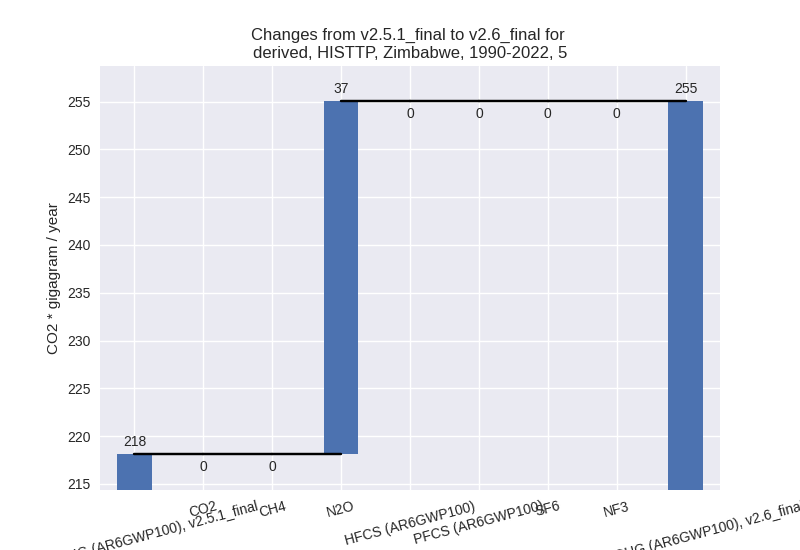Changes in PRIMAP-hist v2.6_final compared to v2.5.1_final for Zimbabwe
2024-09-24
Johannes Gütschow
Change analysis for Zimbabwe for PRIMAP-hist v2.6_final compared to v2.5.1_final
Overview over emissions by sector and gas
The following figures show the aggregate national total emissions excluding LULUCF AR6GWP100 for the country reported priority scenario. The dotted linesshow the v2.5.1_final data.
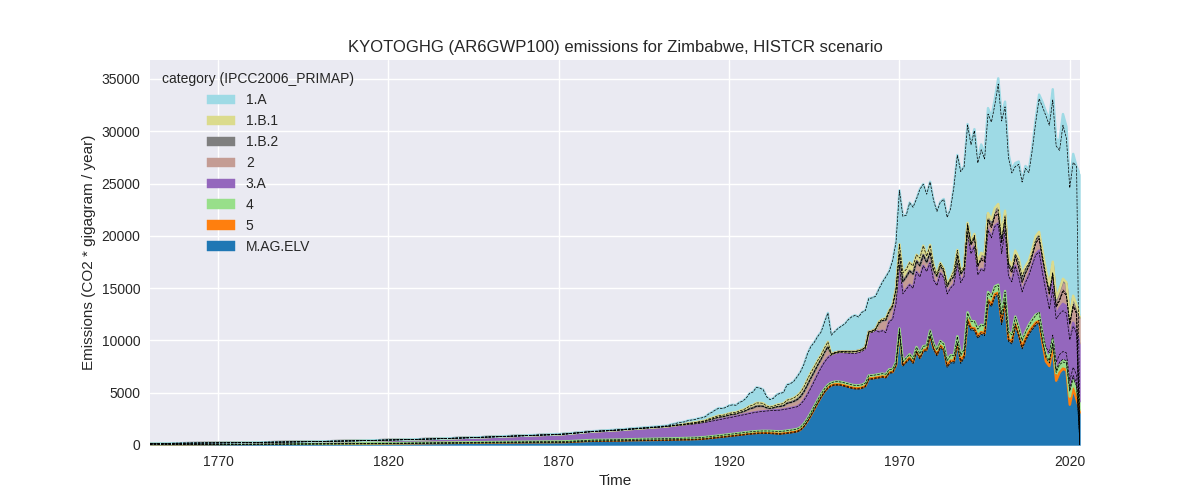
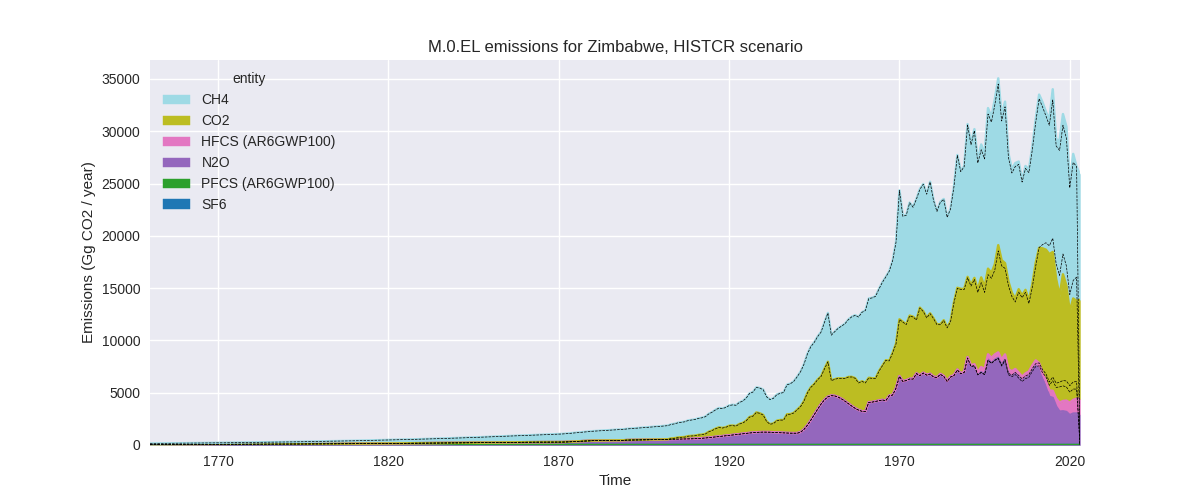
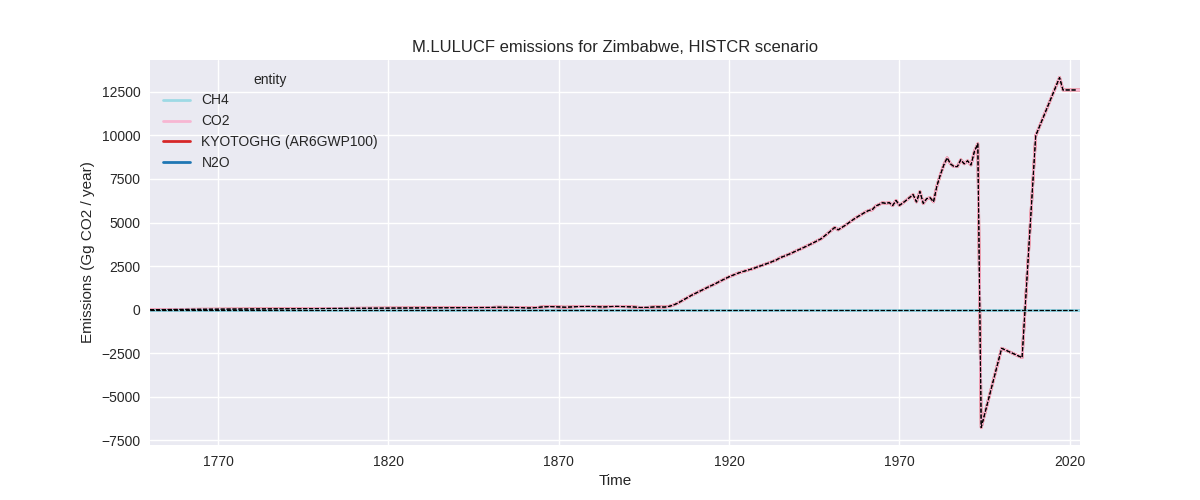
The following figures show the aggregate national total emissions excluding LULUCF AR6GWP100 for the third party priority scenario. The dotted linesshow the v2.5.1_final data.
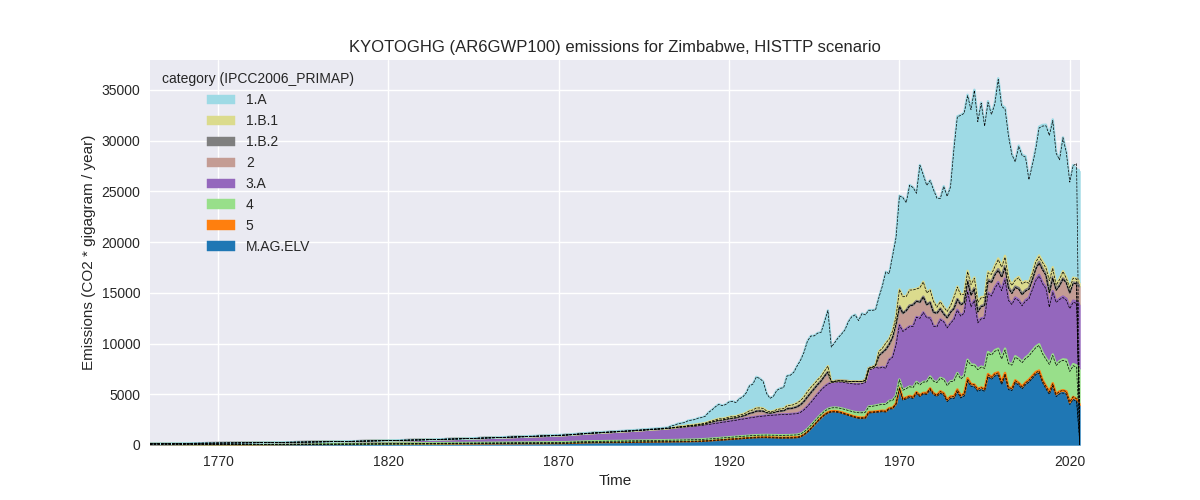
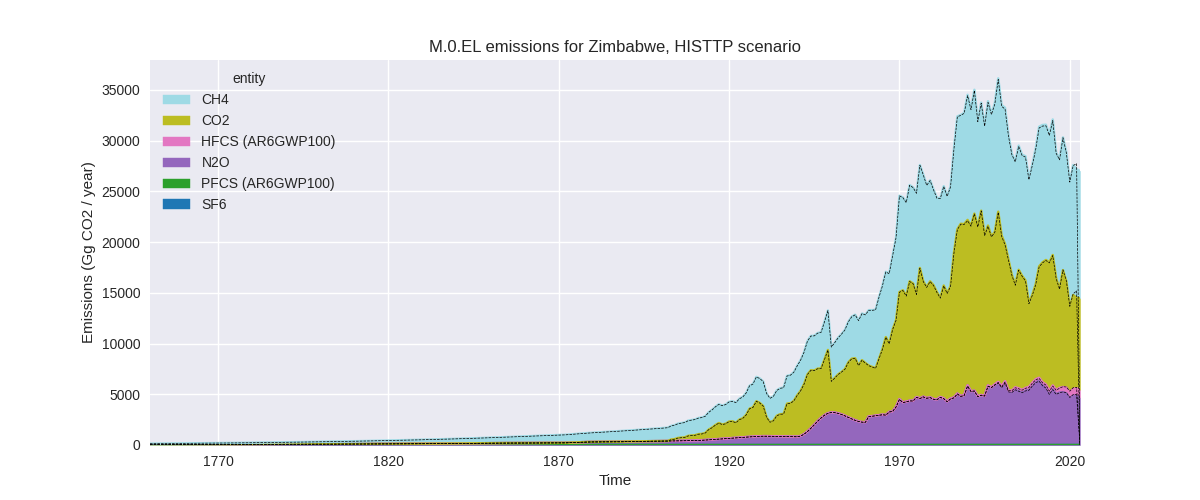

Overview over changes
In the country reported priority scenario we have the following changes for aggregate Kyoto GHG and national total emissions excluding LULUCF (M.0.EL):
- Emissions in 2022 have changed by -0.1%% (-26.95 Gg CO2 / year)
- Emissions in 1990-2022 have changed by 1.6%% (465.66 Gg CO2 / year)
In the third party priority scenario we have the following changes for aggregate Kyoto GHG and national total emissions excluding LULUCF (M.0.EL):
- Emissions in 2022 have changed by -1.9%% (-532.32 Gg CO2 / year)
- Emissions in 1990-2022 have changed by 0.2%% (68.20 Gg CO2 / year)
Most important changes per scenario and time frame
In the country reported priority scenario the following sector-gas combinations have the highest absolute impact on national total KyotoGHG (AR6GWP100) emissions in 2022 (top 5):
- 1: M.AG.ELV, N2O with -2179.81 Gg CO2 / year (-53.3%)
- 2: 3.A, CH4 with 1597.04 Gg CO2 / year (40.9%)
- 3: 2, HFCS (AR6GWP100) with 688.39 Gg CO2 / year (95.0%)
- 4: 1.A, CO2 with -636.81 Gg CO2 / year (-7.2%)
- 5: M.AG.ELV, CH4 with 626.62 Gg CO2 / year (40.9%)
In the country reported priority scenario the following sector-gas combinations have the highest absolute impact on national total KyotoGHG (AR6GWP100) emissions in 1990-2022 (top 5):
- 1: M.AG.ELV, N2O with -607.90 Gg CO2 / year (-10.5%)
- 2: 3.A, CH4 with 426.30 Gg CO2 / year (8.4%)
- 3: 2, HFCS (AR6GWP100) with 351.47 Gg CO2 / year (146.7%)
- 4: M.AG.ELV, CH4 with 292.56 Gg CO2 / year (6.8%)
- 5: 5, N2O with 36.92 Gg CO2 / year (16.9%)
In the third party priority scenario the following sector-gas combinations have the highest absolute impact on national total KyotoGHG (AR6GWP100) emissions in 2022 (top 5):
- 1: 1.A, CO2 with -597.67 Gg CO2 / year (-7.2%)
- 2: 4, CH4 with 165.56 Gg CO2 / year (5.6%)
- 3: 2, N2O with -103.33 Gg CO2 / year (-50.5%)
- 4: 5, N2O with -16.38 Gg CO2 / year (-5.8%)
- 5: 4, N2O with 14.22 Gg CO2 / year (9.0%)
In the third party priority scenario the following sector-gas combinations have the highest absolute impact on national total KyotoGHG (AR6GWP100) emissions in 1990-2022 (top 5):
- 1: 4, CH4 with 59.76 Gg CO2 / year (2.6%)
- 2: 5, N2O with 36.92 Gg CO2 / year (16.9%)
- 3: 1.A, CO2 with -18.51 Gg CO2 / year (-0.2%)
- 4: 2, N2O with -13.85 Gg CO2 / year (-6.1%)
- 5: 4, N2O with 3.62 Gg CO2 / year (3.1%)
Notes on data changes
Here we list notes explaining important emissions changes for the country. ’' means that the following text only applies to the TP time series, while means that it only applies to the CR scenario. Otherwise the note applies to both scenarios.
- We have fixed a problem with the downscaling of BUR1 data for agriculture which affected agricultural emissions post 2010.
- Energy CO2 is lower in 2022 because of adjusted data in EI2024.
Changes by sector and gas
For each scenario and time frame the changes are displayed for all individual sectors and all individual gases. In the sector plot we use aggregate Kyoto GHGs in AR6GWP100. In the gas plot we usenational total emissions without LULUCF. ## country reported scenario
2022
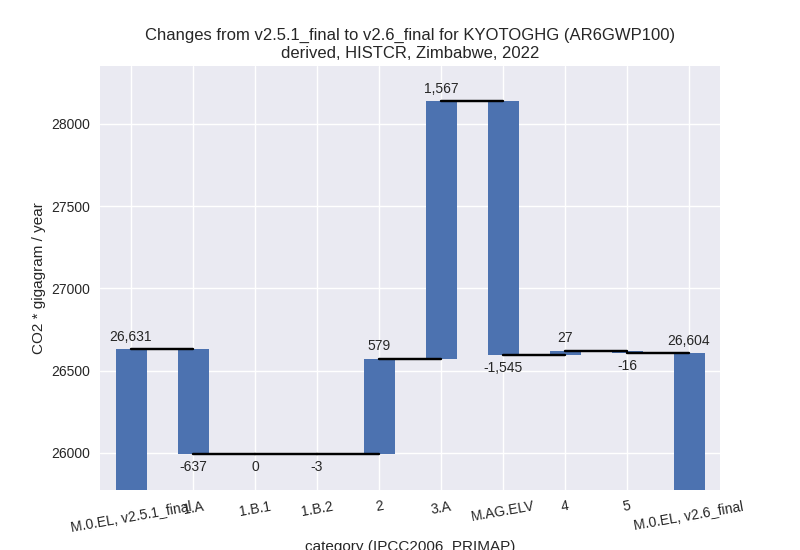
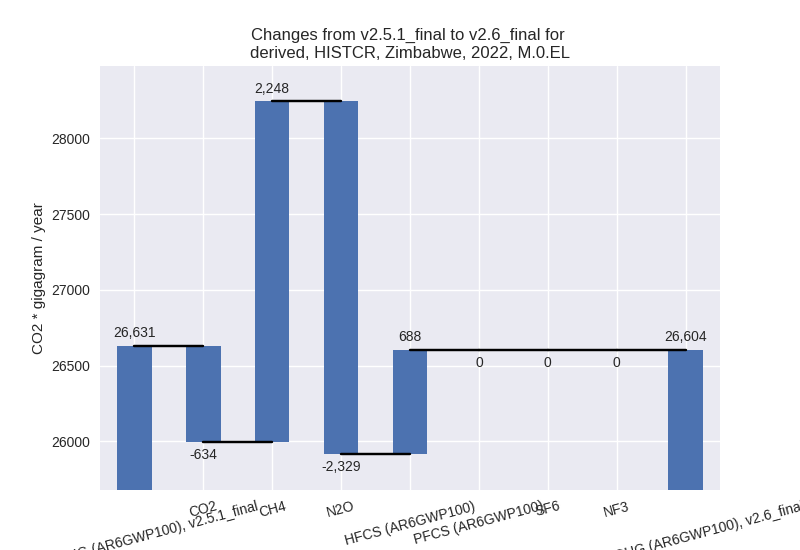
1990-2022

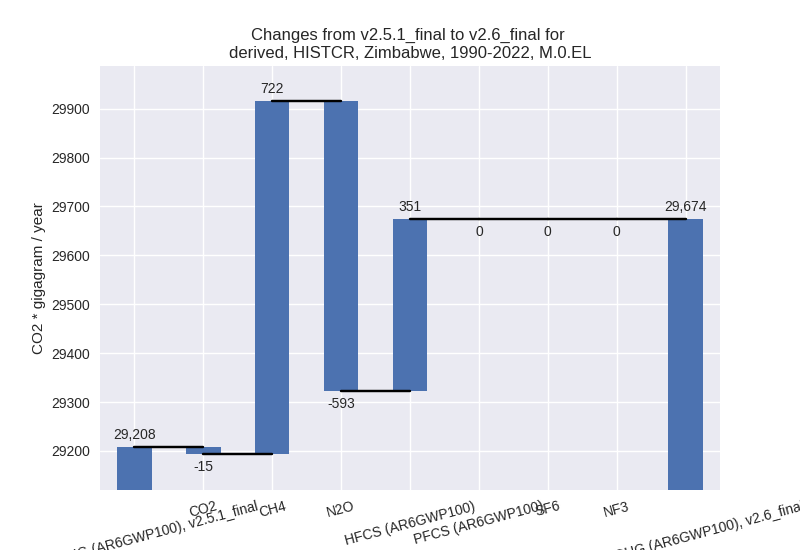
third party scenario
2022
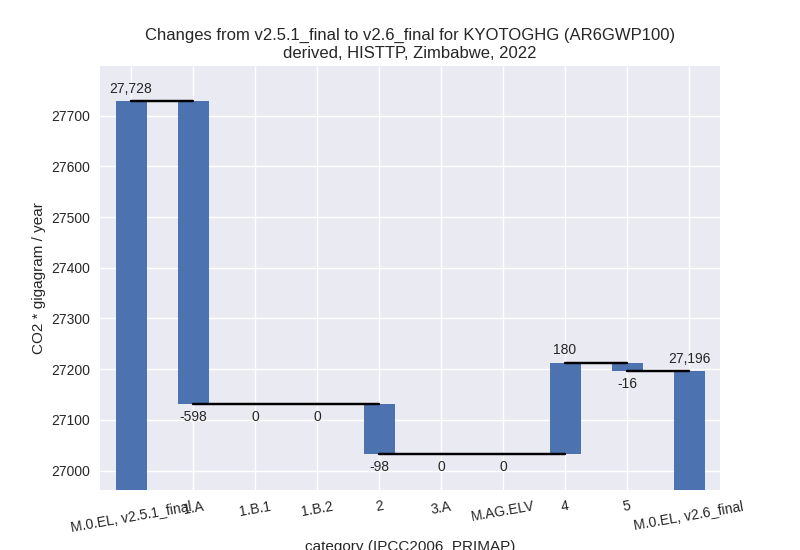
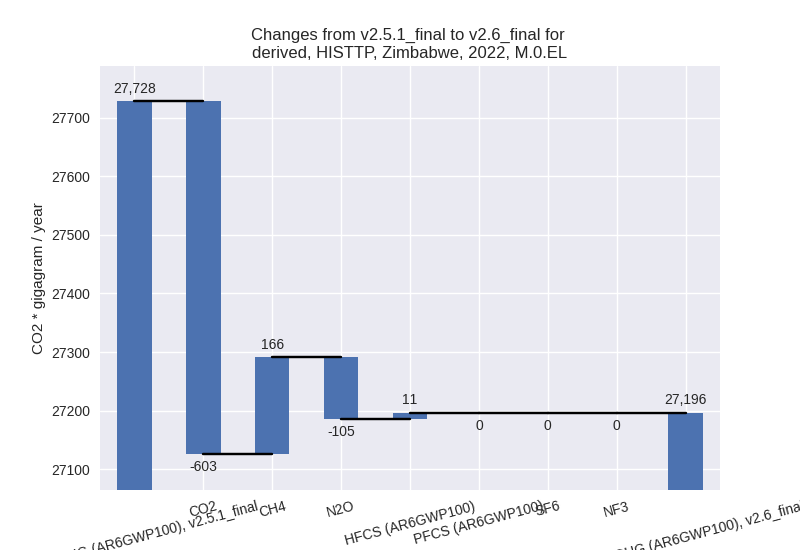
1990-2022
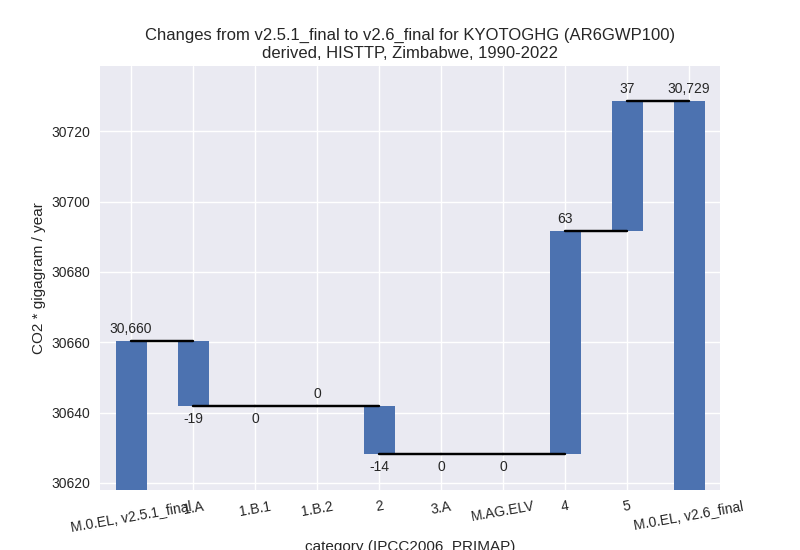
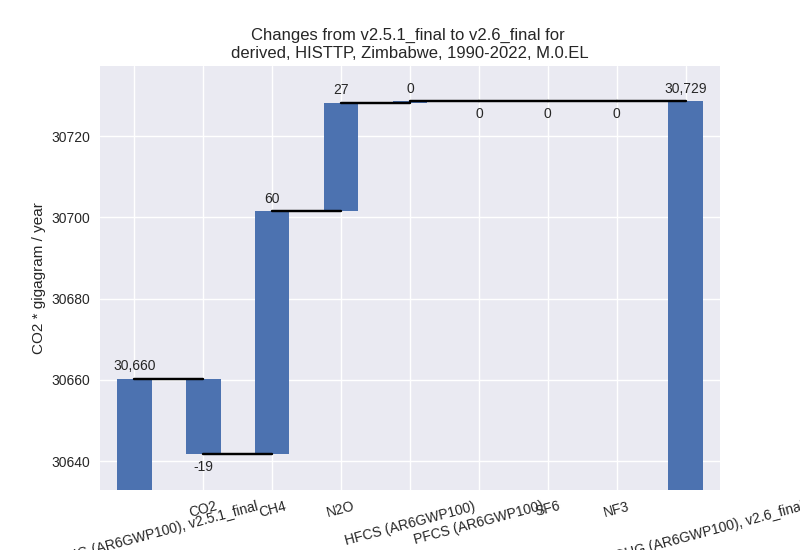
Detailed changes for the scenarios:
country reported scenario (HISTCR):
Most important changes per time frame
For 2022 the following sector-gas combinations have the highest absolute impact on national total KyotoGHG (AR6GWP100) emissions in 2022 (top 5):
- 1: M.AG.ELV, N2O with -2179.81 Gg CO2 / year (-53.3%)
- 2: 3.A, CH4 with 1597.04 Gg CO2 / year (40.9%)
- 3: 2, HFCS (AR6GWP100) with 688.39 Gg CO2 / year (95.0%)
- 4: 1.A, CO2 with -636.81 Gg CO2 / year (-7.2%)
- 5: M.AG.ELV, CH4 with 626.62 Gg CO2 / year (40.9%)
For 1990-2022 the following sector-gas combinations have the highest absolute impact on national total KyotoGHG (AR6GWP100) emissions in 1990-2022 (top 5):
- 1: M.AG.ELV, N2O with -607.90 Gg CO2 / year (-10.5%)
- 2: 3.A, CH4 with 426.30 Gg CO2 / year (8.4%)
- 3: 2, HFCS (AR6GWP100) with 351.47 Gg CO2 / year (146.7%)
- 4: M.AG.ELV, CH4 with 292.56 Gg CO2 / year (6.8%)
- 5: 5, N2O with 36.92 Gg CO2 / year (16.9%)
Changes in the main sectors for aggregate KyotoGHG (AR6GWP100) are
- 1: Total sectoral emissions in 2022 are 13435.08 Gg
CO2 / year which is 50.5% of M.0.EL emissions. 2022 Emissions have
changed by -4.5% (-639.62 Gg CO2 /
year). 1990-2022 Emissions have changed by -0.2% (-20.31 Gg CO2 / year). For 2022 the
changes per gas
are:

The changes come from the following subsectors:- 1.A: Total sectoral emissions in 2022 are 13230.09
Gg CO2 / year which is 98.5% of category 1 emissions. 2022 Emissions
have changed by -4.6% (-636.81 Gg
CO2 / year). 1990-2022 Emissions have changed by -0.2% (-19.72 Gg CO2 / year). For 2022 the
changes per gas
are:
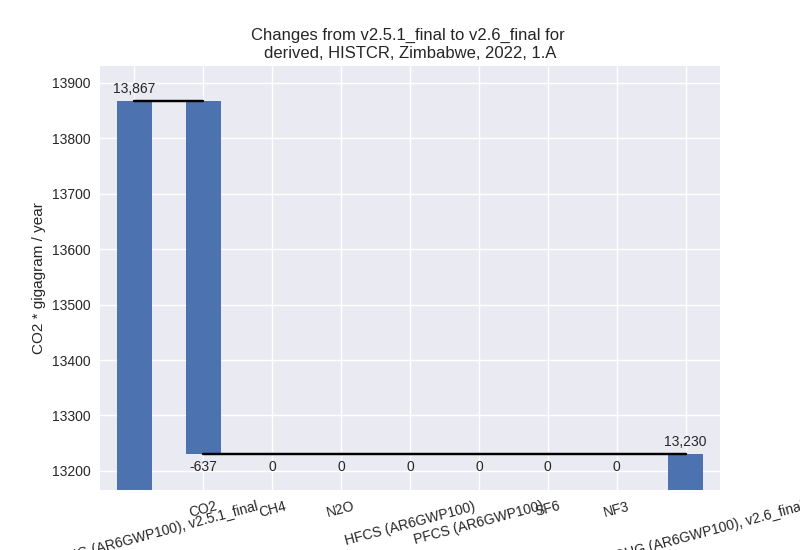
There is no subsector information available in PRIMAP-hist. - 1.B.1: Total sectoral emissions in 2022 are 204.98 Gg CO2 / year which is 1.5% of category 1 emissions. 2022 Emissions have changed by 0.0% (0.00 Gg CO2 / year). 1990-2022 Emissions have changed by 0.0% (0.00 Gg CO2 / year).
- 1.B.2: Total sectoral emissions in 2022 are 0.00 Gg
CO2 / year which is 0.0% of category 1 emissions. 2022 Emissions have
changed by -100.0% (-2.80 Gg CO2 /
year). 1990-2022 Emissions have changed by -100.0% (-0.59 Gg CO2 / year). For 2022
the changes per gas
are:
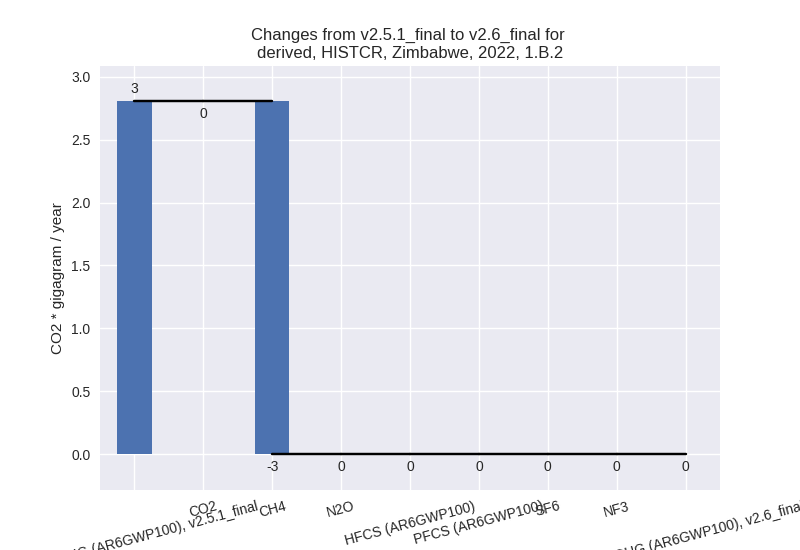
For 1990-2022 the changes per gas are: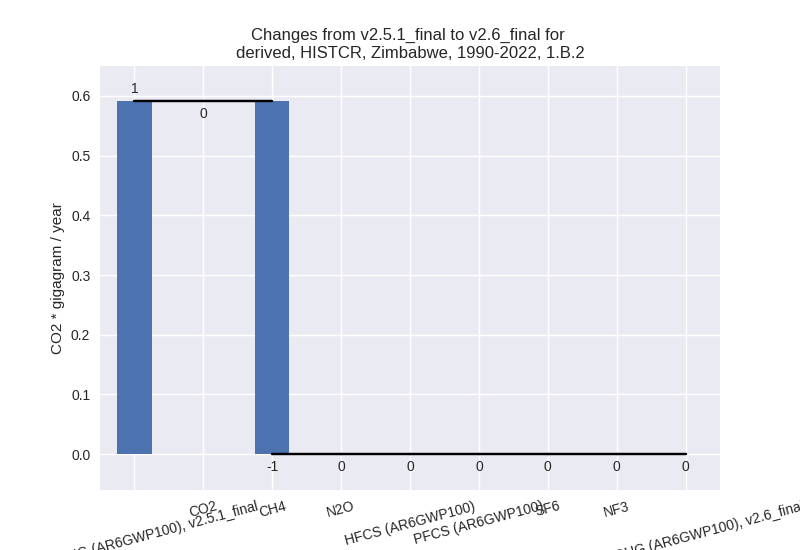
There is no subsector information available in PRIMAP-hist.
- 1.A: Total sectoral emissions in 2022 are 13230.09
Gg CO2 / year which is 98.5% of category 1 emissions. 2022 Emissions
have changed by -4.6% (-636.81 Gg
CO2 / year). 1990-2022 Emissions have changed by -0.2% (-19.72 Gg CO2 / year). For 2022 the
changes per gas
are:
- 2: Total sectoral emissions in 2022 are 2479.08 Gg
CO2 / year which is 9.3% of M.0.EL emissions. 2022 Emissions have
changed by 30.5% (579.38 Gg CO2 /
year). 1990-2022 Emissions have changed by 29.9% (337.45 Gg CO2 / year). For 2022 the
changes per gas
are:
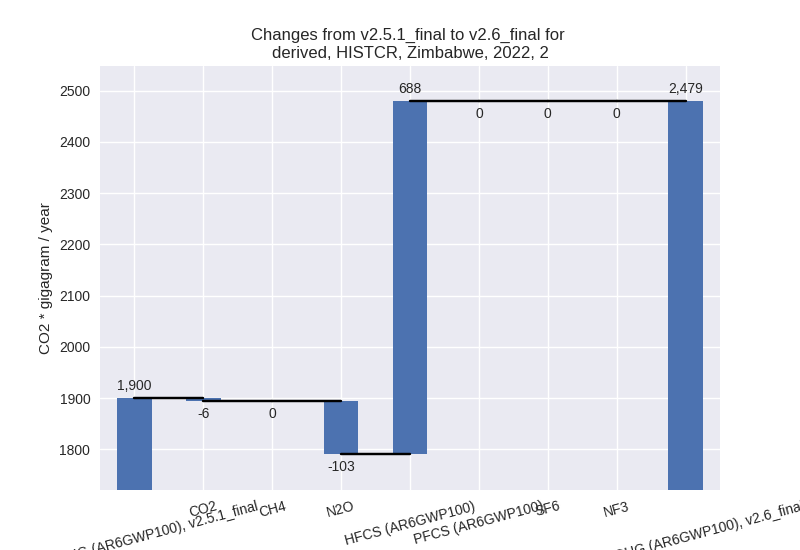
For 1990-2022 the changes per gas are: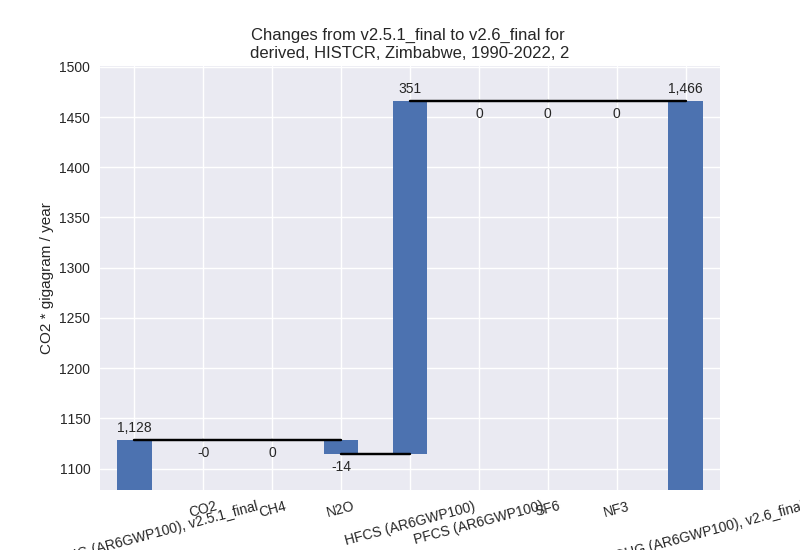
- M.AG: Total sectoral emissions in 2022 are 9608.33 Gg CO2 / year which is 36.1% of M.0.EL emissions. 2022 Emissions have changed by 0.2% (22.37 Gg CO2 / year). 1990-2022 Emissions have changed by 0.7% (107.94 Gg CO2 / year).
- 4: Total sectoral emissions in 2022 are 812.85 Gg
CO2 / year which is 3.1% of M.0.EL emissions. 2022 Emissions have
changed by 3.5% (27.30 Gg CO2 /
year). 1990-2022 Emissions have changed by 0.5% (3.66 Gg CO2 / year). For 2022 the
changes per gas
are:
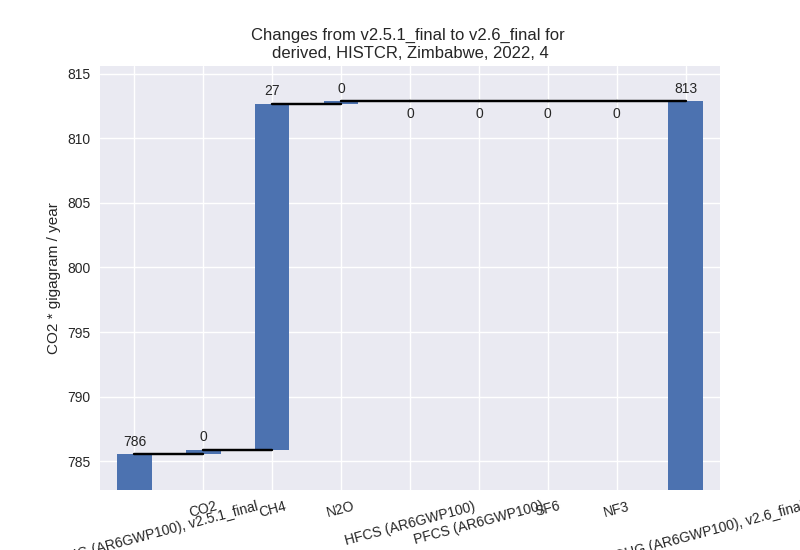
- 5: Total sectoral emissions in 2022 are 268.36 Gg
CO2 / year which is 1.0% of M.0.EL emissions. 2022 Emissions have
changed by -5.8% (-16.38 Gg CO2 /
year). 1990-2022 Emissions have changed by 16.9% (36.92 Gg CO2 / year). For 2022 the
changes per gas
are:
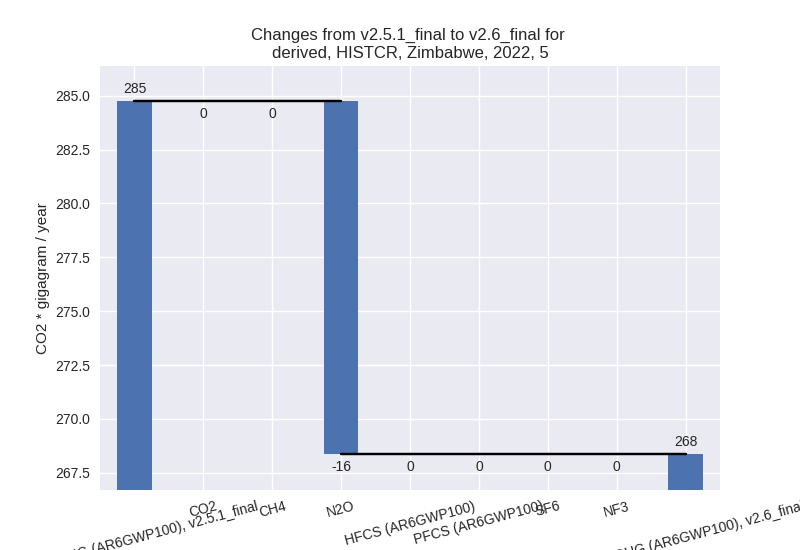
For 1990-2022 the changes per gas are: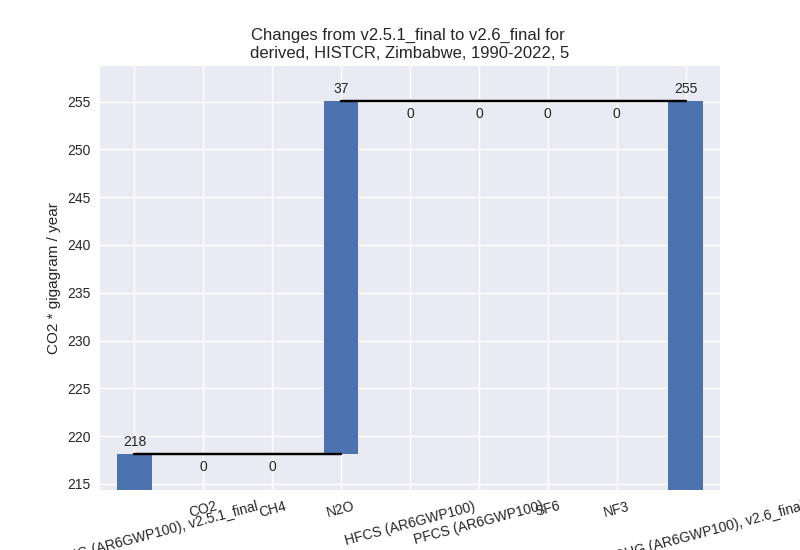
third party scenario (HISTTP):
Most important changes per time frame
For 2022 the following sector-gas combinations have the highest absolute impact on national total KyotoGHG (AR6GWP100) emissions in 2022 (top 5):
- 1: 1.A, CO2 with -597.67 Gg CO2 / year (-7.2%)
- 2: 4, CH4 with 165.56 Gg CO2 / year (5.6%)
- 3: 2, N2O with -103.33 Gg CO2 / year (-50.5%)
- 4: 5, N2O with -16.38 Gg CO2 / year (-5.8%)
- 5: 4, N2O with 14.22 Gg CO2 / year (9.0%)
For 1990-2022 the following sector-gas combinations have the highest absolute impact on national total KyotoGHG (AR6GWP100) emissions in 1990-2022 (top 5):
- 1: 4, CH4 with 59.76 Gg CO2 / year (2.6%)
- 2: 5, N2O with 36.92 Gg CO2 / year (16.9%)
- 3: 1.A, CO2 with -18.51 Gg CO2 / year (-0.2%)
- 4: 2, N2O with -13.85 Gg CO2 / year (-6.1%)
- 5: 4, N2O with 3.62 Gg CO2 / year (3.1%)
Changes in the main sectors for aggregate KyotoGHG (AR6GWP100) are
- 1: Total sectoral emissions in 2022 are 11263.55 Gg
CO2 / year which is 41.4% of M.0.EL emissions. 2022 Emissions have
changed by -5.0% (-597.67 Gg CO2 /
year). 1990-2022 Emissions have changed by -0.1% (-18.47 Gg CO2 / year). For 2022 the
changes per gas
are:
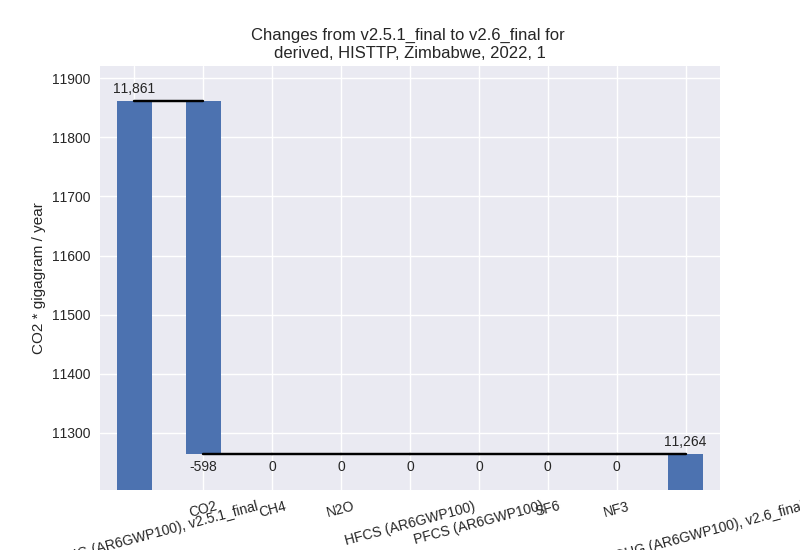
The changes come from the following subsectors:- 1.A: Total sectoral emissions in 2022 are 10779.70
Gg CO2 / year which is 95.7% of category 1 emissions. 2022 Emissions
have changed by -5.3% (-597.67 Gg
CO2 / year). 1990-2022 Emissions have changed by -0.1% (-18.51 Gg CO2 / year). For 2022 the
changes per gas
are:
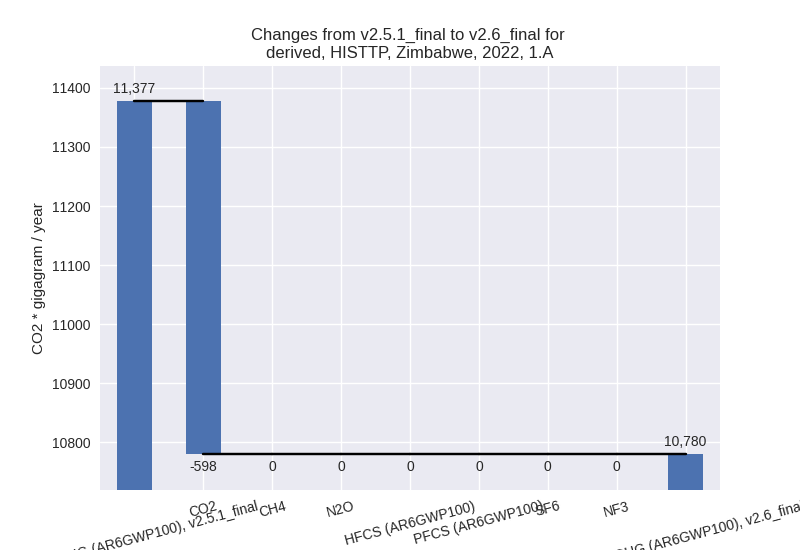
There is no subsector information available in PRIMAP-hist. - 1.B.1: Total sectoral emissions in 2022 are 481.05 Gg CO2 / year which is 4.3% of category 1 emissions. 2022 Emissions have changed by 0.0% (0.00 Gg CO2 / year). 1990-2022 Emissions have changed by 0.0% (0.00 Gg CO2 / year).
- 1.B.2: Total sectoral emissions in 2022 are 2.80 Gg
CO2 / year which is 0.0% of category 1 emissions. 2022 Emissions have
changed by 0.0% (0.00 Gg CO2 /
year). 1990-2022 Emissions have changed by 6.3% (0.04 Gg CO2 / year). For 1990-2022
the changes per gas
are:
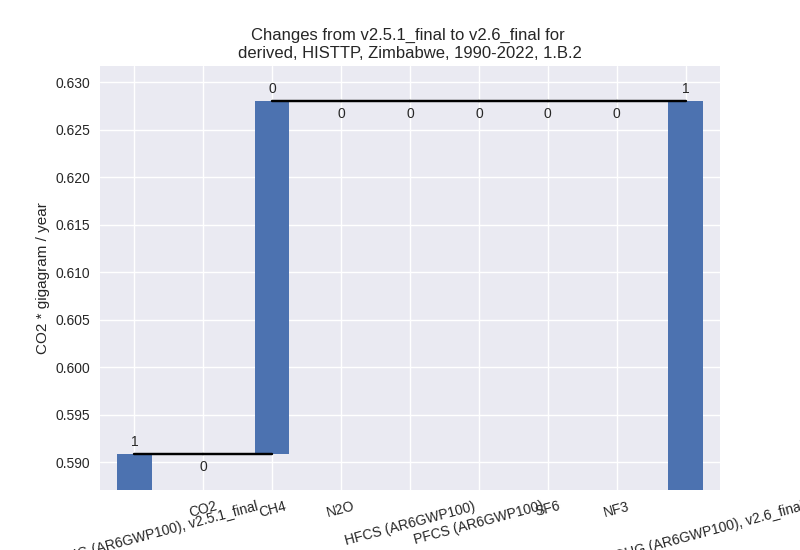
There is no subsector information available in PRIMAP-hist.
- 1.A: Total sectoral emissions in 2022 are 10779.70
Gg CO2 / year which is 95.7% of category 1 emissions. 2022 Emissions
have changed by -5.3% (-597.67 Gg
CO2 / year). 1990-2022 Emissions have changed by -0.1% (-18.51 Gg CO2 / year). For 2022 the
changes per gas
are:
- 2: Total sectoral emissions in 2022 are 1817.94 Gg
CO2 / year which is 6.7% of M.0.EL emissions. 2022 Emissions have
changed by -5.1% (-98.39 Gg CO2 /
year). 1990-2022 Emissions have changed by -1.1% (-13.70 Gg CO2 / year). For 2022 the
changes per gas
are:

- M.AG: Total sectoral emissions in 2022 are 10541.97 Gg CO2 / year which is 38.8% of M.0.EL emissions. 2022 Emissions have changed by 0.0% (0.00 Gg CO2 / year). 1990-2022 Emissions have changed by 0.0% (0.00 Gg CO2 / year).
- 4: Total sectoral emissions in 2022 are 3304.24 Gg
CO2 / year which is 12.1% of M.0.EL emissions. 2022 Emissions have
changed by 5.8% (180.13 Gg CO2 /
year). 1990-2022 Emissions have changed by 2.6% (63.44 Gg CO2 / year). For 2022 the
changes per gas
are:

For 1990-2022 the changes per gas are: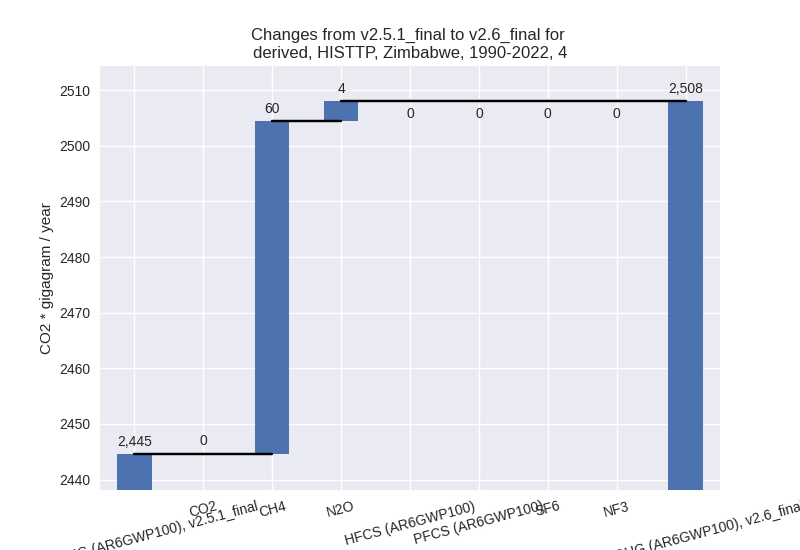
- 5: Total sectoral emissions in 2022 are 268.36 Gg
CO2 / year which is 1.0% of M.0.EL emissions. 2022 Emissions have
changed by -5.8% (-16.38 Gg CO2 /
year). 1990-2022 Emissions have changed by 16.9% (36.92 Gg CO2 / year). For 2022 the
changes per gas
are:
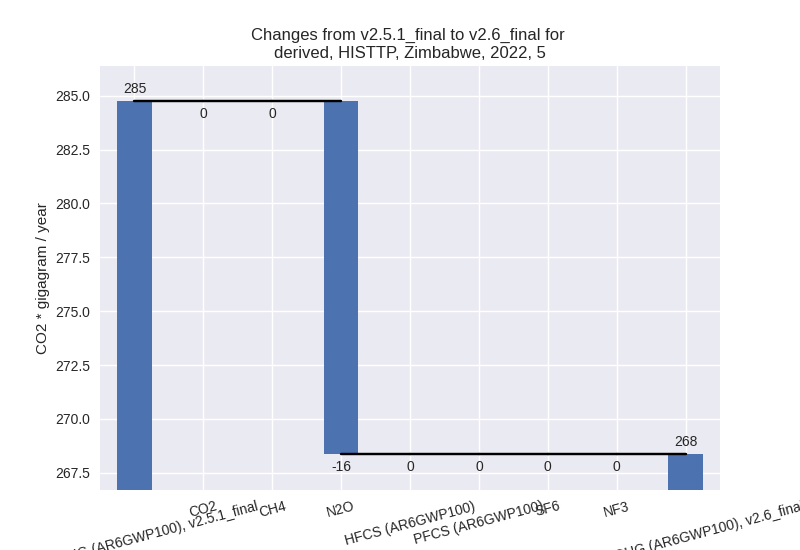
For 1990-2022 the changes per gas are: